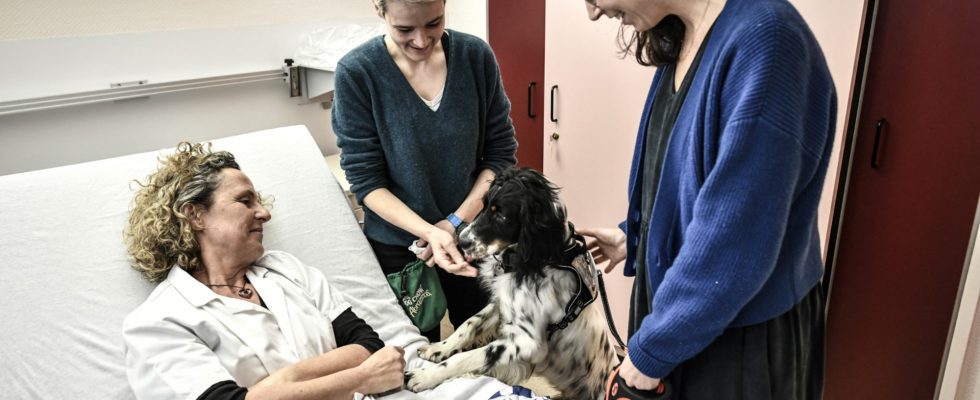It relaxes patients in the waiting room, triggers smiles before an anxiety-provoking treatment, and makes you forget about cancer: Snoopy, the new “recruit” of the Institut Curie in Paris, is a dog who also creates a link between caregivers.
This is the first time that a hospital in France has had a full-time dog in a care unit. Other countries, such as the United States or Canada, make more extensive use of these “therapeutic” or “mediation” animals, mainly cats and dogs.
We discover Snoopy, a two-year-old black and white English setter, adopted at the SPA, comfortably installed in the office of the “Research, Wounds and Healing Unit” of the Parisian anti-cancer center, at the origin of the project.
Create a link between caregivers and patients
The whole team is very caring, not stingy with caresses and always quick to throw him a kibble. Arrived in mid-December, their new “work colleague”, as they like to call him, seems to have integrated quickly.
Isabelle Fromantin, the team manager, insists: “it was a project imagined by all the members of the service”. “We wondered how to create a link between caregivers and patients,” explains the nurse-researcher. “In a place where you often have to go fast, he brings a kind of humanity”.
“Cancer is a considerable ordeal for patients and their loved ones,” she continues. “He gives them a little smile”. Various studies indicate that during therapy, the presence of an animal increases the patient’s participation.
Just look at the reactions of patients in the waiting room when they see him arrive, eager for hugs: his arrival breaks the silence, triggering spontaneous conversations.
At 75, Laurette Duponchel, treated at Curie for carcinoma on her foot, does not hide her joy at finding him: “seeing him brings me a lot of well-being, comfort”, she lights up. “It can also be beneficial to those who have no family, or few visitors,” she says.
Among Snoopy’s future missions: to be alongside patients who want it shortly before anxiety-provoking treatment, especially children.
“Shared custody”
For reasons of hygiene and safety, he never enters the treatment rooms and does not visit patients who are too fragile. Every two or three weeks, education sessions are organized within the hospital to teach him certain skills. “We teach him to interact with a patient, to lie down in front of him, to put his paws on the bed or to put his muzzle down to be petted”, explains Aurélie Nuzillard, canine educator.
Each mastered exercise will be a good opportunity to earn kibble. His official owner, Marguerite Nicodeme, an advanced practice nurse, chose him according to very specific criteria: “we wanted a medium-sized dog so that it wouldn’t be too impressive, with drooping ears for the ‘reassuring’ side and who is sociable, who can interact with patients of any age”, she lists.
“Since it was a team project, we decided that he would live in ‘shared custody’, sleeping alternately with several members of the service,” she adds.
If the arrival of Snoopy delighted many patients, it also made it possible to bring together caregivers who sometimes crossed paths in the corridors without knowing each other. The adoption of this dog is also part of a study to assess its benefit in the hospital setting.
“We want to be able to measure the well-being brought to a patient by a four-legged companion and see if it really improves the quality of life at work in the hospital”, specifies Professor Steven Le Gouill, director of the ensemble. Hospital of the Institute.
